Spring is a wonderful time to start a new hobby. If you’ve never made soap before, make sure to stop by my tutorial pages and check out my book: Natural Soap Making Book for Beginners. Handmade soap is fun, frugal, and healthy. Below, I’ll teach you how to make 3 Spring handmade vegan soap recipes that use herbs and oils that are beneficial for those with Spring allergies or utilize spring herbs and other plants.
Essential Oils for Allergies
There are a number of essential oils that tend to help people with Spring allergies. I talk about these in more detail in 2 Allergy Relief Soap Recipes.
I have Spring allergies that tend to get worse or better, depending on age, current health, and how everything blooms. I’ve found that certain essential oils help more than others. They can calm itchy eyes and throat, and relax irritated skin from brushing up against plants while weeding.
Here’s a list of my favorites:
These can be used in a diffuser, on a leather bracelet, or (what I like best) in soap so that it is applied directly to the skin. The aromatherapy benefits are still great in a soap bar.
I’ve used a combination of some of these oils in the soap recipe below. It’s vegan and nut free for those who need it.
Don’t forget that you can change the essential oils used below to others in the list below, keeping the amount the same. You can also add these same oils to another recipe. For example, if you prefer a tallow soap, just use your favorite tallow soap recipe and add the essential oils below or those in the list above.
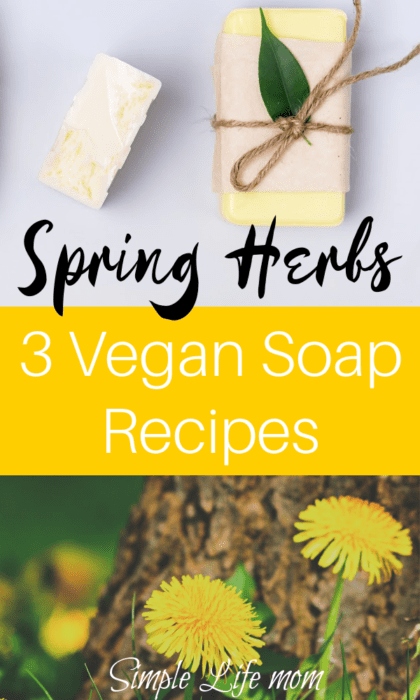
Why Vegan Soap Recipes?
I love a good tallow or lard soap. They make amazing soaps that are hard and moisturizing. A number of people have a hard time getting hold of good, healthy tallow and lard though.
If you’d rather have a tallow recipe, use one of the other recipes on my website here and then incorporate these essential oil blends instead of the ones suggested in the recipe. That and choosing a cleansing, but moisturizing recipe with a slightly higher superfat content than 5% will go a long way with soothing seasonal allergies.
These are also hard and luxurious bars below, so have fun making these soap recipes with butters and oils that add pH balance, moisture, and bubbles to great bars.
Allergy Relief Soap Recipe – Nut Free Vegan Soap Recipe
Makes: 12 four ounce bars
Superfat: 10%
Ingredients:
- 10 ounces olive oil
- 8 ounces babassu oil
- 4 ounces shea butter
- 4 ounces apricot kernel oil
- 4 ounces cocoa butter
- 3 ounces castor oil
- 4.3 ounces lye
- 12 ounces water
- 0.25 ounces basil essential oil
- 0.5 ounces eucalyptus essential oil
- 0.5 ounces bergamot essential oil
Directions:
- Weigh olive oil, babassu oil, shea butter, apricot kernel oil, cocoa butter, and castor oil and add to a large stainless steel pot and heat on low until everything is melted. Allow to cool to 90-100 degrees Fahrenheit.
- Put on protective eye gear and gloves and weigh lye into a zip close bag and set aside. Weigh water and take both the water and lye outside. Put on a charcoal mask and carefully add lye into the water and stir until dissolved. Allow to cool to 90-100 degrees Fahrenheit.
- Prepare the mold by lining if necessary.
- When lye water and oil are both around 90-100 degrees, pour lye water into large pot of oils and blend with a hand mixer until light to medium trace.
- Add essential oils and blend until incorporated.
- Pour into mold. Cover and insulate for 24 hours.
- Remove soap from mold. If it seems too soft to remove, wait another 6 hours and recheck. Cut the soap into 12 four ounce bars and allow to cure in a well ventilated location for 3-6 weeks.
I’ve put this recipe into a printable form below to make it easier to print and have in front of you while you’re creating.
Allergy Relief Soap Recipe – Vegan and Nut Free
Equipment
Ingredients
- 10 ounces olive oil
- 8 ounces babassu oil
- 4 ounces shea butter
- 4 ounces apricot kernel oil
- 4 ounces cocoa butter
- 3 ounces castor oil
- 4.3 ounces lye
- 12 ounces water
- 0.25 ounces basil essential oil
- 0.50 ounces eucalyptus essential oil
- 0.50 ounces bergamot essential oil
Instructions
- Weigh olive oil, babassu oil, shea butter, apricot kernel oil, cocoa butter, and castor oil and add to a large stainless steel pot. Heat on low until everything is melted. Allow to cool to 90-100 degrees Fahrenheit.10 ounces olive oil, 8 ounces babassu oil, 4 ounces shea butter, 4 ounces apricot kernel oil, 4 ounces cocoa butter, 3 ounces castor oil
- Put on protective eye gear and gloves and weigh lye by pouring into a zip close bag. Weigh water and take both lye and water outside. Put on a charcoal mask and carefully pour lye into the water and stir until lye is dissolved. Allow to cool to 90-100 degrees Fahrenheit.4.3 ounces lye, 12 ounces water
- Prepare the mold by lining if necessary.
- When lye water and oil are both around 100 degrees, pour lye water into large pot of oils and blend with a hand mixer until light to medium trace.
- Add essential oils and blend until incorporated.0.25 ounces basil essential oil, 0.50 ounces eucalyptus essential oil, 0.50 ounces bergamot essential oil
- Pour into mold. Cover and insulate for 24 hours.
- Remove soap from mold. If it seems too soft to remove, wait another 6 hours and recheck. Cut the soap into 12 four-ounce bars and allow to cure in a well ventilated location for 3-6 weeks.
Spring Herbs for Soap Making
There are a few plants that pop up in your yard and garden that are actually amazingly good for your skin and body. The top on my list in dandelions!
Dandelions are a plant that most people have growing in their front yards and can identify easily. When infused into oil, dandelions have anti-inflammation properties and can help with sore joints. It also helps with the detox process.
You can learn all about the great properties it provides by reading how to make dandelion oil here.
It’s a wonderful herb to add to soap!
How to Make Dandelion Oil
To make this recipe, you’ll need to gather some dandelions from the yard. Pull up the root and all. The best dandelion oil is made with root, leaves, and flowers, but use what you can get your hands on.
Wash the dandelion parts. You’ll need 1 cup of dandelion parts.
Dandelion Oil Recipe
- 1 cup fresh dandelion leaves, roots, and/or flowers
- 1-1/2 cups olive oil
Directions:
- Gather dandelion leaves, root, and or/flowers and make sure they are clean and dry.
- Place dandelions and oil in a saucepan over low heat. Do not let boil. Stir and gently mash dandelion to the sides and bottom of the pan on and off for 15 minutes.
- Remove from heat and allow to cool.
- Strain and use the olive oil in your soap recipe.
Dandelion Vegan Soap Recipe
I’ve added eucalyptus and lemon essential oils to this recipe for an herbal and bright scent, but feel free to switch up the essential oils, using about 1 ounce total.
Makes: 12 four ounce bars
Superfat: 5%
Ingredients:
- 12 ounces dandelion infused olive oil (see instructions)
- 9 ounces coconut oil
- 7 ounces cocoa butter
- 3 ounces sweet almond oil
- 2 ounces avocado oil
- 4.7 ounces lye
- 10.6 ounces water
- 0.5 ounces eucalyptus essential oil
- 0.5 ounces lemon essential oil
Directions:
- Make dandelion oil by gathering dandelion leaves, root, and or/flowers and make sure they are clean and dry. Place dandelions and oil in a saucepan over low heat. Do not let boil. Stir and gently mash dandelion to the sides and bottom of the pan on and off for 15 minutes. Strain and use the olive oil in this soap recipe.
- Weigh dandelion infused olive oil, coconut oil, cocoa butter, sweet almond oil, and avocado oil and add to a large stainless steel pot and heat on low until everything is melted. Allow to cool to 90-100 degrees Fahrenheit.
- Put on protective eye gear and gloves and weigh lye into a zip close bag and set aside. Weigh water and take both the water and lye outside. Put on a charcoal mask and carefully add lye into the water and stir until dissolved. Allow to cool to 90-100 degrees Fahrenheit.
- Prepare the mold by lining if necessary.
- When lye water and oil are both around 90-100 degrees, pour lye water into large pot of oils and blend with a hand mixer until light to medium trace.
- Add essential oils and blend until incorporated.
- Pour into mold. Cover and insulate for 24 hours.
- Remove soap from mold. If it seems too soft to remove, wait another 6 hours and recheck. Cut the soap into 12 four ounce bars and allow to cure in a well ventilated location for 3-6 weeks.
Below is the recipe in printable format. Enjoy!
Dandelion Vegan Soap Recipe
Equipment
Ingredients
- 12 ounces dandelion infused olive oil see instructions
- 9 ounces coconut oil
- 7 ounces cocoa butter
- 3 ounces sweet almond oil
- 2 ounces avocado oil
- 4.7 ounces lye
- 10.6 ounces water
- 0.50 ounces eucalyptus essential oil
- 0.50 ounces lemon essential oil
Instructions
- Make dandelion oil by gathering dandelion leaves, root, and or/flowers and making sure they are clean and dry. Place dandelions and 12 ounces of olive oil in a saucepan over low heat. Do not let boil. Stir and gently mash dandelion to the sides and bottom of the pan on and off for 10-15 minutes. Strain and use the olive oil in this soap recipe.
- Weigh dandelion infused olive oil, coconut oil, cocoa butter, sweet almond oil, and avocado oil and add to a large stainless steel pot and heat on low until everything is melted. Allow to cool to 90-100 degrees Fahrenheit.12 ounces dandelion infused olive oil, 9 ounces coconut oil, 7 ounces cocoa butter, 3 ounces sweet almond oil, 2 ounces avocado oil
- Put on protective eye gear and gloves and weigh lye into a zip close bag and set aside. Weigh water and take both the water and lye outside. Put on a charcoal mask and carefully add lye into the water and stir until dissolved. Allow to cool to 90-100 degrees Fahrenheit.4.7 ounces lye, 10.6 ounces water
- Prepare the mold by lining if necessary.
- When lye water and oil are both around 90-100 degrees, pour lye water into large pot of oils and blend with a hand mixer until light to medium trace.
- Add essential oils and blend until incorporated.0.50 ounces eucalyptus essential oil, 0.50 ounces lemon essential oil
- Pour into mold. Cover and insulate for 24 hours.Remove soap from mold. If it seems too soft to remove, wait another 6 hours and recheck. Cut the soap into 12 four ounce bars and allow to cure in a well ventilated location for 3-6 weeks.
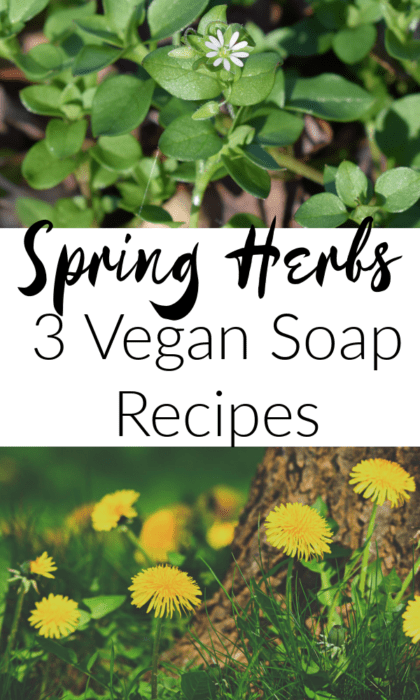
Another herb that’s available in the spring is chickweed. It’s one of the first “weeds” that start growing in the spring and are seen by many farmers as a good sign to move plants outdoors.
Chickweed is filled with flavonoids, phenolic acid, saponins, coumarins, and terpenoids. Today, besides being a great addition to your salad, chickweed is used for topical treatments because of its soothing abilities. It’s a great combination with June’s jewelweed for those who suffer summer itchiness and irritated skin due to poison ivy or other irritations.
I’ve added a few other allergy relief essential oils to the vegan soap recipe below so that you can get the aromatherapy and herbal benefits from chickweed and the essential oils.
Chickweed Soothing Soap-Vegan Soap Recipe
- 12 ounces chickweed infused olive oil (see instructions)
- 9 ounces coconut oil
- 7 ounces cocoa butter
- 3 ounces sweet almond oil
- 2 ounces avocado oil
- 4.7 ounces lye
- 10.6 ounces water
- 0.5 ounces lavender essential oil
- 0.5 ounces bergamot essential oil
- Make chickweed oil by gathering chickweed leaves and make sure they are clean and dry. Place chickweed and oil in a saucepan over low heat. Do not let boil. Stir and gently mash to the sides and bottom of the pan on and off for 15 minutes. Strain and use the olive oil in this soap recipe.
- Weigh chickweed infused olive oil, coconut oil, cocoa butter, sweet almond oil, and avocado oil and add to a large stainless steel pot and heat on low until everything is melted. Allow to cool to 90-100 degrees Fahrenheit.
- Put on protective eye gear and gloves and weigh lye into a zip close bag and set aside. Weigh water and take both the water and lye outside. Put on a charcoal mask and carefully add lye into the water and stir until dissolved. Allow to cool to 90-100 degrees Fahrenheit.
- Prepare the mold by lining if necessary.
- When lye water and oil are both around 90-100 degrees, pour lye water into large pot of oils and blend with a hand mixer until light to medium trace.
- Add essential oils and blend until incorporated.
- Pour into mold. Cover and insulate for 24 hours.
- Remove soap from mold. If it seems too soft to remove, wait another 6 hours and recheck. Cut the soap into 12 four ounce bars and allow to cure in a well ventilated location for 3-6 weeks.
Here’s the recipe in printable format:
Soothing Chickweed Vegan Soap Recipe
Equipment
Ingredients
- 12 ounces chickeed infused olive oil
- 9 ounces coconut oil
- 6 ounces cocoa butter
- 2 ounces apricot kernel oil
- 2 ounces shea butter
- 2 ounces castor oil
- 10.5 ounces water
- 4.6 ounces lye
- 0.50 ounces bergamot essential oil
- 0.50 ounces lavender essential oil
Instructions
- Make chickweed oil by gathering chickweed leaves and make sure they are clean and dry. Place chickweed and oil in a saucepan over low heat. Do not let boil. Stir and gently mash to the sides and bottom of the pan on and off for 15 minutes. Strain and use the olive oil in this soap recipe.12 ounces chickeed infused olive oil
- Weigh chickweed infused olive oil, coconut oil, cocoa butter, sweet almond oil, and avocado oil and add to a large stainless steel pot and heat on low until everything is melted. Allow to cool to 90-100 degrees Fahrenheit.12 ounces chickeed infused olive oil, 9 ounces coconut oil, 6 ounces cocoa butter, 2 ounces apricot kernel oil, 2 ounces shea butter, 2 ounces castor oil
- Put on protective eye gear and gloves and weigh lye into a zip close bag and set aside. Weigh water and take both the water and lye outside. Put on a charcoal mask and carefully add lye into the water and stir until dissolved. Allow to cool to 90-100 degrees Fahrenheit.4.6 ounces lye, 10.5 ounces water
- Prepare the mold by lining if necessary.
- When lye water and oil are both around 90-100 degrees, pour lye water into large pot of oils and blend with a hand mixer until light to medium trace.
- Add essential oils and blend until incorporated.0.50 ounces bergamot essential oil, 0.50 ounces lavender essential oil
- Pour into mold. Cover and insulate for 24 hours.Remove soap from mold. If it seems too soft to remove, wait another 6 hours and recheck. Cut the soap into 12 four ounce bars and allow to cure in a well ventilated location for 3-6 weeks.


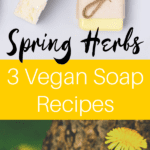
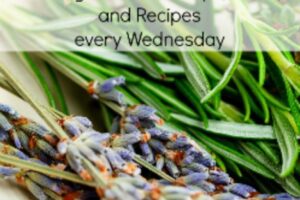
 I love how you’ve shared not just one, but three spring-inspired handmade vegan soap recipes — each with its own unique blend of natural ingredients and scents. The way you incorporate essential oils and herbs makes them feel so fresh and seasonal. I especially appreciate the focus on vegan and natural alternatives — it’s getting harder to find truly clean DIY skincare tutorials these days. Thanks for making it so easy to follow with clear instructions. Can’t wait to try the chamomile and calendula soap for a gentle, calming bar!
I love how you’ve shared not just one, but three spring-inspired handmade vegan soap recipes — each with its own unique blend of natural ingredients and scents. The way you incorporate essential oils and herbs makes them feel so fresh and seasonal. I especially appreciate the focus on vegan and natural alternatives — it’s getting harder to find truly clean DIY skincare tutorials these days. Thanks for making it so easy to follow with clear instructions. Can’t wait to try the chamomile and calendula soap for a gentle, calming bar!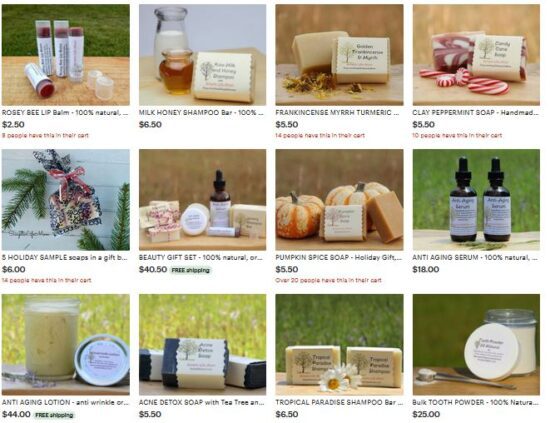
4 Comments
Leave your reply.